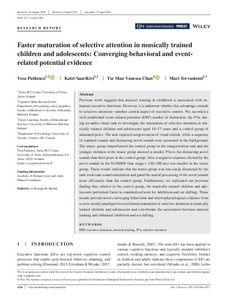Faster maturation of selective attention in musically trained children and adolescents: Converging behavioral and event-related potential evidence
Putkinen Vesa; Saarikivi Katri; Chan Tsz Man Vanessa; Tervaniemi Mari
Faster maturation of selective attention in musically trained children and adolescents: Converging behavioral and event-related potential evidence
Putkinen Vesa
Saarikivi Katri
Chan Tsz Man Vanessa
Tervaniemi Mari
WILEY
Julkaisun pysyvä osoite on:
https://urn.fi/URN:NBN:fi-fe2021093048783
https://urn.fi/URN:NBN:fi-fe2021093048783
Tiivistelmä
Previous work suggests that musical training in childhood is associated with enhanced executive functions. However, it is unknown whether this advantage extends to selective attention-another central aspect of executive control. We recorded a well-established event-related potential (ERP) marker of distraction, the P3a, during an audio-visual task to investigate the maturation of selective attention in musically trained children and adolescents aged 10-17 years and a control group of untrained peers. The task required categorization of visual stimuli, while a sequence of standard sounds and distracting novel sounds were presented in the background. The music group outperformed the control group in the categorization task and the younger children in the music group showed a smaller P3a to the distracting novel sounds than their peers in the control group. Also, a negative response elicited by the novel sounds in the N1/MMN time range (similar to 150-200 ms) was smaller in the music group. These results indicate that the music group was less easily distracted by the task-irrelevant sound stimulation and gated the neural processing of the novel sounds more efficiently than the control group. Furthermore, we replicated our previous finding that, relative to the control group, the musically trained children and adolescents performed faster in standardized tests for inhibition and set shifting. These results provide novel converging behavioral and electrophysiological evidence from a cross-modal paradigm for accelerated maturation of selective attention in musically trained children and adolescents and corroborate the association between musical training and enhanced inhibition and set shifting.
Kokoelmat
- Rinnakkaistallenteet [27094]
